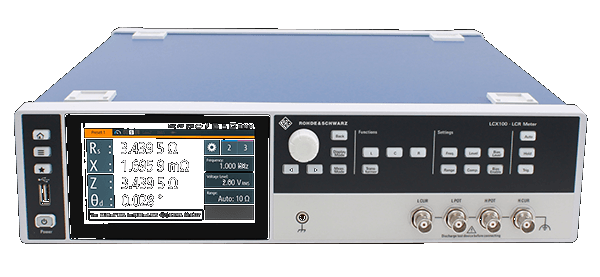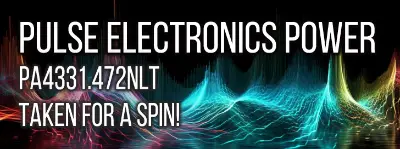Explore the Capabilities of the KYOCERA AVX NOSB476M006R0500 Niobium Oxide Capacitor
By Mark Harris Monday, 23 January 2023

Introduction
The following technical review is a detailed analysis of the performance of the KYOCERA AVX NOSB476M006R0500 Niobium Oxide Capacitor compared to a statistical benchmark formed from other capacitors of the same value. This evaluation aims to provide transparency, competence, impartiality, accuracy, and instructional value to qualified engineers considering this component for their circuits. To facilitate this comparison, LCR measurements at 1 Volt and 6.3 Volts are provided for the NOSB476M006R0500, alongside benchmark data.
- Pros:
- Low series resistances: The NOSB476M006R0500 consistently performs at or below the benchmark data, making it a good choice for applications requiring efficient energy transfer and low power loss.
- High Quality Factor at lower test frequencies: The component showcases a respectable quality factor compared to the benchmark in the lower test frequency range, which may be an important consideration for some applications.
- Cons:
- High dissipation factor: At higher test frequencies, the NOSB476M006R0500 exhibits a higher dissipation factor than the benchmark, suggesting energy loss in the form of heat and leading to decreased efficiency in those applications.
- Narrow nominal capacitance range: The nominal capacitance value of this capacitor is 47μF, providing limited flexibility for circuit designers who require additional capacitance options within their applications.
In the following sections, we provide an in-depth analysis of the NOSB476M006R0500's performance in terms of capacitance, series resistance, dissipation factor, and quality factor in comparison to the benchmark data.
}Capacitance
The NOSB476M006R0500 capacitance was measured under varying test frequencies and two differing voltage conditions: 1V and 6.3V. The measured series capacitance values were then juxtaposed with the statistical benchmark formed from other components with the same nominal capacitance value.
Under 1V conditions, this capacitor exhibits higher-than-average series capacitance values across most frequencies up to 650kHz when compared to the benchmark data. It significantly outperforms the average across lower frequencies (up to 50kHz), with values ranging from 52.36μF (at 10kHz) to 59.69μF (at 5kHz). The performance exhibits a decline after 50kHz, but remains higher than the average until 650kHz. Notably, in the 700kHz to 950kHz frequency range, the measured capacitance values surpass the maximum value of the benchmark data. This anomaly could be attributable to this specific component's parameters or ambient temperature conditions during measurements.
When tested under 6.3V conditions, the capacitor's performance follows a similar trend to that observed at 1V, with generally higher capacitance values than the benchmark average up to 50kHz. However, a remarkably high capacitance of 731.8μF is seen at 5kHz, which could indicate device-specific variations or the influence of temperature during testing. The capacitor maintains better-than-average performance in other frequencies and begins to approach or fall below average values at higher frequencies (>650kHz). It is interesting to note the decreasing measured capacitance values in the 700kHz to 1MHz frequency range.
In summary, this capacitor demonstrates higher-than-average capacitance values under both 1V and 6.3V conditions compared to the benchmark data across most frequency ranges tested. It excels particularly in the lower frequency range up to 50kHz. Nonetheless, engineers should be cautious of the higher-than-maximum benchmark capacitance values in the 700kHz to 950kHz frequency range, as these discrepancies warrant further investigation to substantiate their relevance in certain applications. Barring these anomalies, the NOSB476M006R0500 capacitor is an optimal choice for most general applications with primary considerations in the tested frequency ranges.
Series Resistance
The NOSB476M006R0500 capacitor demonstrates varying levels of series resistance when subjected to different test frequencies at 1 volt. Specifically, its resistance ranges from 214.5 ohms at 5 Hz to 87.59 milliohms at 1 MHz. This trend indicates that the capacitor generally has a lower series resistance at higher frequencies.
When comparing the NOSB476M006R0500 capacitor to an average capacitor taken from a statistical benchmark, the component tends to perform significantly better within certain frequency ranges, such as 50 Hz (1.003 ohms vs. 3.037 ohms), 20 kHz (188.9 milliohms vs. 319.4 milliohms), and 50 kHz (152.3 milliohms vs. 295.7 milliohms). Nonetheless, its performance suffers in other frequency ranges, particularly the lower ones, where a notable difference can be observed at 5 Hz (214.5 ohms vs. 44.75 ohms) and 10 Hz (62.21 ohms vs. 18.59 ohms).
Upon increasing the voltage to 6.3 volts for LCR measurements, the NOSB476M006R0500 capacitor continues to show lower series resistance at higher frequency ranges. Once again, when compared to the statistical benchmark, the capacitor excels within some specific frequency ranges, such as 20 kHz (203.9 milliohms vs. 319.4 milliohms) and 100 kHz (117.1 milliohms vs. 298.3 milliohms). However, the performance of this capacitor still falls short of the benchmark at lower frequency ranges like 5 Hz (128.9 ohms vs. 44.75 ohms) and 10 Hz (102.7 ohms vs. 18.59 ohms).
It is essential to consider these variations in series resistance when selecting a capacitor for a specific application. The capacitor's suitability depends on the desired frequency range and voltage levels within the intended operating environment. The NOSB476M006R0500 capacitor's performance in higher frequency ranges may make it an ideal choice for various applications, while other specific use cases might require capacitors with better performance at lower frequencies.
Impedance
In the lower frequency range, the NOSB476M006R0500 demonstrates a satisfactory impedance performance when compared to the benchmark. At 1V and 5Hz, the measured impedance value of 581.6 Ohms is notably closer to the benchmark's minimum of 539.4 Ohms, but still falls within the average range of 656.9 Ohms. A similar trend is observed at 10Hz, where the impedance value of 310.5 Ohms nests between the benchmark minimum and average values of 295.5 Ohms and 332.8 Ohms, respectively.
However, as test frequencies increase, the NOSB476M006R0500's impedance performance exhibits more apparent deviations from the benchmark values. For instance, at a 1kHz test frequency with an input voltage of 1V, the measured impedance is 3.377 Ohms. This value is below the benchmark average of 4.046 Ohms but remains within the acceptable range. The capacitor's performance continues to deviate from the benchmark average at higher test frequencies, like 5kHz, 10kHz, and 50kHz, with corresponding impedance values of 725.2m Ohms, 420.2m Ohms, and 191.6m Ohms.
When tested at 100kHz, the measured impedance of 147.3m Ohms is significantly lower than the benchmark average of 319.4m Ohms. Still, it falls within the acceptable range. As test frequencies increase, the capacitor's performance consistently deviates from the benchmark average impedance. However, the impedance values remain within the specified range at all times.
When tested at 6.3V, the NOSB476M006R0500 exhibits similar trends in impedance performance. In the lower frequency range, the capacitor generally performs closer to the benchmark's minimum values. As the frequency increases, the deviations from the benchmark impedance averages become more pronounced. These results suggest that the capacitor's impedance performance is highly influenced by both the input voltage and test frequency, with performance diverging from the benchmark values at higher frequencies, while still maintaining acceptability within the designated range.
Comparative Analysis
In evaluating the NOSB476M006R0500 capacitor manufactured by KYOCERA AVX, its performance was compared to the statistical benchmark data derived from other components with the same value. This comparison gives us insights into how this particular capacitor performs relative to other capacitors in its class, both in terms of quality and potential applications.
At the test voltage of 1 Volt, the NOSB476M006R0500 exhibits a higher impedance compared to the statistical benchmark, particularly at lower frequencies. From 5 kHz onwards, the impedance begins to stabilize and falls closer to the benchmark values. It is important to note that the measured dissipation factor is generally higher than the average benchmark values across the entire frequency range. This implies higher power losses in the capacitor, with the distinction being most pronounced at lower frequencies. However, the NOSB capacitor exhibits relatively high-quality factors at frequencies above 50 Hz, indicating favorable capacitor performance in terms of reactive power handling.
The series resistance and capacitance of the NOSB capacitor deviate from the statistical benchmark; however, this deviation tends to normalize at higher frequencies. Specifically, the series resistance of the NOSB capacitor lies significantly below the benchmark at frequencies above 5 kHz. This finding suggests that the capacitor has a lower equivalent series resistance (ESR) at these higher frequencies, which is advantageous for applications that require low power dissipation. When the test voltage is increased to 6.3 Volts, the observed variations become more prominent. Regardless, the impedance, dissipation factor, and quality factor appear to converge with the benchmark values as the frequency increases. This pattern is in line with the observations made at the 1 Volt test voltage.
In summary, this comparative analysis of the NOSB476M006R0500 capacitor provides valuable insights into its performance characteristics. By understanding how it compares to the benchmark, engineers can make more informed decisions about whether to use this component based on their specific applications and requirements.
Conclusion
The KYOCERA AVX NOSB476M006R0500 capacitor was reviewed against a statistical benchmark formed from other components of the same value. The comparison focused on the performance metrics such as impedance, series resistance, dissipation factor, quality factor and capacitance across a range of frequencies.
From the provided component data and benchmark data, the NOSB476M006R0500 capacitor has displayed a higher impedance than the benchmark average value across almost all test frequencies, with the largest deviation at low frequencies (5 Hz and 10 Hz). The series resistance values were also consistently higher than the benchmark averages, with the largest differences at the lower test frequencies. However, the difference decreases for high frequencies (above 500 kHz).
The capacitor's dissipation factor showed a mixed performance when compared to the benchmark averages. In some test frequencies (e.g., 50 Hz), the capacitor had a remarkably low dissipation factor when compared to the benchmark range, indicating good performance in terms of energy dissipation. Conversely, it displayed considerably higher dissipation factor values at other frequencies, such as 5 Hz and 600 kHz.
Quality factor measurements were lower than the benchmark average across most test frequencies. Particularly at low frequencies, the calculated quality factors were considerably lower, indicating the capacitor's performance might not meet certain strict standards in terms of energy conservation and efficiency in those applications.
In conclusion, while the NOSB476M006R0500 capacitor demonstrates suitable overall performance across various frequencies for general electronic applications, the higher impedance and series resistance values, and the lower quality factors as compared to the statistical benchmark might be of concern for certain demanding applications or high precision designs.
Dissipation Factor and Quality Factor
In this section, we'll analyze the performance of the KYOCERA AVX Niobium Oxide Capacitor (NOSB476M006R0500) based on its Dissipation Factor (Df) and Quality Factor (Q). Lower Df values are preferable, while higher Q values signify a better-performing capacitor.
At 1 Volt, the NOSB476M006R0500 exhibits a Df ranging from 0.414 at 5Hz to 0.011 at 800kHz, while the Q factor is in the range of 2.43 at 5Hz to 0.11 at 1MHz. Notably, the capacitor's performance in terms of Df appears to be the best around the 50-100Hz range (with Df=0.015 and 0.017, respectively). The Q factor at this range stays above 60, which suggests relatively good performance.
At the higher test voltage of 6.3 Volts, the capacitor shows variation in its Df and Q values. The Df ranges from 2.989 at 5Hz to 0.891 at 1MHz, while the Q factor spans from 0.33 at 5Hz to 0.89 at 1MHz. The peak performance in terms of Df is observed around 100Hz (Df=0.192), while the Q factor is relatively good at around 500Hz (Q=24.21).
When comparing the NOSB476M006R0500 capacitor against the statistical benchmark, it is evident that the capacitor delivers a decent performance in the lower frequency range, particularly when characterizing it based on its Df and Q data. As an engineer assessing the suitability of the KYOCERA AVX Niobium Oxide Capacitor for use in circuits, it is essential to consider the specific application requirements and whether this component's performance in the lower test frequencies aligns with those needs.
Instruments Used
Rohde & Schwarz LCX200



